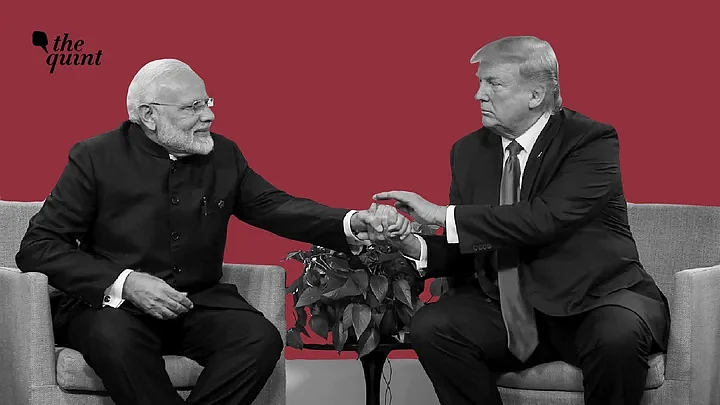
Between Pressure and Partnership: India’s Faustian Bargain with the US
India-US trade negotiations highlight strategic autonomy and cautious pragmatism.

advertisement
After prolonged brinkmanship and diplomatic posturing, the much-anticipated India–US trade deal remains elusive. Despite visible geo-strategic alignment at the macro level, the supposed milestone increasingly resembles a mirage.
The reasons lie not just in contentious issues but in the deeper micro-level trade-offs—marked by asymmetrical power dynamics, divergent national compulsions, and contrasting developmental trajectories—that demand realism, not idealism.
Trade agreements grounded in trust, transparency, and reciprocity are sustainable. Without these, they become transient—what Kautilya termed vyasanasandhi, or a ‘treaty of convenience’.
Adding to this concern is the deal’s movement outside the multilateral World Trade Organisation (WTO) framework, raising questions about its legitimacy and durability. Understanding these negotiations requires looking beyond economics into geostrategic calculations.
Beyond Tariffs: The Geopolitical Undercurrent
In today’s uncertain world of shifting alliances and disruptions, trade deals double as instruments of strategic alignment and national positioning. Every concession and clause signals broader intentions and carries implications for the global order.
For example, while seeking zero-duty access for American goods, the US maintains its own 10-to-20 percent base tariffs and continues to impose duties on Indian steel and aluminum. Additionally, a recent proposal by a US Senator to impose up to 500 percent tariffs on countries trading with Russia shows how quickly geopolitics can distort trade rationality. The threat of such unilateral actions undermines predictability, making trust-building harder.
Strategic Autonomy in the Crosshairs
Washington's broader strategy seems aimed at embedding American regulatory and economic preferences into India's domestic framework. This includes pressuring India to dilute its data localisation norms, remove its equalisation levy on digital services, and open-up sectors like insurance, e-commerce and multi-brand retail.
Even in the tech space, India is being offered limited participation in semiconductor packaging and assembly, while the US retains the higher-value design and fabrication stages. In defense, India faces offers of dated platforms and vague commitments around technology transfer—highlighting Washington’s reluctance to share strategic technologies meaningfully.
India’s Cautious Playbook
India’s response has been marked by restraint and long-term calculation. Instead of rushing into a comprehensive agreement, it has focused on extracting specific, tangible benefits, especially in labor-intensive sectors like textiles, leather, and handicrafts. These industries are critical for employment and exports and face stiff competition from China and Southeast Asian economies.
India’s approach reflects lessons from the Arthashastra’s: risk-minimisation, adaptability, and autonomy. With global supply-chains becoming weaponized and strategic partnerships constantly shifting, India values the US relationship—but not at the cost of its industrial sovereignty. It seeks strategic alignment without compromising domestic red lines in agriculture, MSMEs, pharmaceuticals, or digital services.
On contentious issues, such as GM food, dairy imports, and digital services taxation, India has maintained a stance of cautious pragmatism. Where concessions are made, such as controlled import quotas on select agricultural items, they are narrowly tailored and domestically palatable.
India’s handling of services trade, particularly IT and mobility, has also been measured. With significant Indian stakes in the US economy, abrupt disruptions are avoided. This measured and calibrated strategy ensures steady gains while preserving room for maneuvering.
Resilience Over Quick Wins
India is employing a defensive but patient trade strategy—avoiding high-risk, binding commitments in favour of low-hanging gains. Its counter-tariff proposal of USD 3.82 billion under GATT provisions reflects a rules-based but firm approach. This tit-for-tat move upholds Indian interests without escalating tensions.
Such a strategy helps preserve policy space and create long-term strategic leverage. Given the US's oscillation between partnership and pressure, India needs this flexibility—particularly in the critical services sector, where it enjoys competitive advantage. The caution also ensures India doesn't get locked into commitments that may prove harmful amid shifting global equations.
To optimise outcomes, inter-ministerial coordination and stakeholder alignment will be key. Trade policy today intersects with geopolitics, technology, climate, and defense. In semiconductors, critical minerals, and clean-tech, aligning trade engagements with strategic goals will be vital. These sectors offer not only export potential but also long-term geopolitical leverage.
In sum, the absence of a grand deal should not be mistaken for failure. Success lies in building resilience, preserving sovereignty, and enhancing negotiation leverage over time. India’s patient, step-by-step approach aims not to “win” a deal, but to shape the trajectory of engagement in a way that protects national interests and enables future options.
As John F Kennedy advised, “Let us never negotiate out of fear. But let us never fear to negotiate.” This spirit aptly articulates India’s strategy. While the trade deal may currently appear a mirage, with prudent statecraft and calibrated ambition, it can yet evolve into a meaningful milestone.
(Ram Singh is Professor and Head (MDPs) at the Indian Institute of Foreign Trade with over 20 years of teaching experience. This is an opinion piece and the views expressed above are the author’s own. The Quint neither endorses nor is responsible for the same.)
- Access to all paywalled content on site
- Ad-free experience across The Quint
- Early previews of our Special Projects
Published: undefined